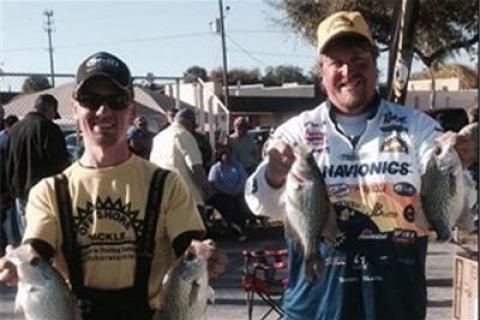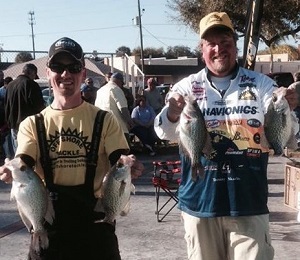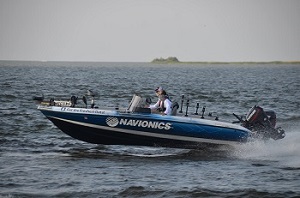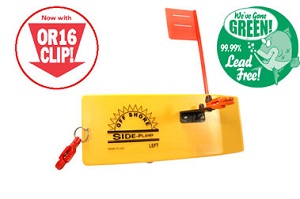
The Do-It Corporation/Off-Shore team of Tommy Skarlis and Kyle Steinfeldt employed a few tactics that are relatively new to southern crappie fishing Feb. 13-14 when they rode a big second day to a runner-up finish in the Crappie Masters All-American Tournament Trail national qualifier on the Harris Chain of Lakes near Tavares, Fla.
Trolling jigs behind Off-Shore's Tadpole in-line trolling divers on Off-Shore OR-12 planer boards, Skarlis and Steinfeldt put together two seven-fish limits for 16.50 pounds and finished close behind winners George Parker and Tim Eberly of Florida (17.19 pounds).
"What we did is going to probably set the crappie world on its ear again," said Skarlis, who also teamed with Steinfeldt to win the 2013 Crappie Masters National Championship on Lake Grenada while trolling crankbaits behind Off-Shore boards
This time, the third-year crappie tournament anglers had limited time to prefish due to the long trip from Iowa and they were greeted by a cold front on the morning of the two-day tournament.
"We woke up to temps in the high 30s or low 40s," noted Skarlis. "It was unseasonably cool for Florida."
Coupled with a change in wind direction and current, the conditions sent the Iowa team scrambling on the first day. Their top spot produced only three crappies.
"The key, especially when you're trolling, is to keep moving. If you drag the right stuff in front of those open-water suspended crappies, they're gonna eat," Skarlis explained. "We moved to another area and found a fairly hot pack of fish. We caught six more and ended up with a respectable seven-fish limit of 6.87 pounds that was good for 13th place."
On a body of water that hasn't been known for producing huge weights lately, Skarlis and Steinfeldt had some ground to make up on day two.
"We figured about 8 1/2 pounds was about the max that you could weigh right now," said Skarlis. "We knew it would be difficult to win the tournament, but we also knew we could get right back in the hunt if we could get some of those bigger fish to bite again."
The cold front persisted into day two, but Skarlis and Steinfeldt had the right presentation. Trolling 1/32nd-ounce mylar jigs tipped with the smallest minnows in the bucket, they went to an area where they'd caught two decent fish before the tournament, but nothing big.
"You can't ignore fish," said Skarlis. "If there are average fish in an area like that, there are usually bigger ones somewhere nearby."
 Skarlis and Steinfeldt set up a two-mile trolling pass between the waypoints where they caught their pre-fishing crappies. Then Skarlis noticed, thanks to fresh Navionics lake data he had downloaded, that both fish were caught on a 12-foot contour line. Once they zeroed in on that depth, the planer boards started going back. Skarlis estimates they caught more than 60 crappies on the second day and sorted out a 9.63-pound limit that was one of the largest in recent tournament history.
Skarlis and Steinfeldt set up a two-mile trolling pass between the waypoints where they caught their pre-fishing crappies. Then Skarlis noticed, thanks to fresh Navionics lake data he had downloaded, that both fish were caught on a 12-foot contour line. Once they zeroed in on that depth, the planer boards started going back. Skarlis estimates they caught more than 60 crappies on the second day and sorted out a 9.63-pound limit that was one of the largest in recent tournament history.
"Traditionally tactics in Florida consist of either tight-lining, which is basically spider-rigging or fishing directly under the bow of the boat and slow-trolling along, or long-lining jigs 40 or more feet behind the boat," Skarlis explained. "We felt we had to capitalize on every bite and be as efficient as we could and go through as many fish as possible to have a chance. That's where our trolling set-up made all the difference. Instead of letting out all that line on eight rods, with the Tadpoles and the Off-Shore boards we could set our lines in about a third of the time."
Off Shore planer boards and St. Croix Eyecon rods rigged with Abu Line-counter reels and 10# test Trilene XT proved to be the best delivery system for Skarlis and Steinfeldt
"We also found out during practice that very few bites were coming right next to the boat or in the boat wash. Out of the 60 fish we caught on the second day, only two came on rods without planer boards. The boards got our jigs away from the boat and let us turn a 40-foot spread into a 350-foot spread. That made all the difference in the world, just like it did when we won the championship on Lake Grenada.
"Another key was paying close attention to the Navionics data and staying on that 12- to 13-foot contour line. If you got shallower, you didn't get bit and later in the day the bigger fish moved off the contour over deeper water, but they stayed at the same depth."
Skarlis and Steinfeldt basically used walleye trolling gear to catch their fish, starting with 8-foot St. Croix EyeCon trolling rods coupled with Abu Garcia 6500 LC (line-counter) reels loaded with Berkley Trilene XT in 10-pound test. A leader of clear 10-pound XT connected a two-jig set-up to the Tadpoles.
"One reason we stuck with the 10-pound test is because it's tough and abrasion-resistent, and it's also the same diameter that's used to develop the Precision Trolling dive curves for both the Tadpoles and assorted crankbaits," said Skarlis. "The planer boards handle that diameter of line really well, too."
Skarlis and Steinfeldt also used the electric motors on their boat for propulsion.
"Being able to troll silently all day was important, too, and our Optima batteries made that possible," Skarlis said. "We trolled from 7 a.m. to 3:30 p.m. and if it weren't for the power and the long lasting energy of the Optimas, we wouldn't have been able to do that."
It was especially satisfying, Skarlis added, to succeed using a new approach that is only beginning to make its way into the crappie world. "It's so much fun," he said. "It's a presentation that takes your baits through fish that aren't spooked by the boat so they are more apt to bite. It makes the average angler more successful. The fish were just voracious eating those jigs. They jerked those boards right back. It was a great visual. It was some of the most enjoyable fishing I've had in my life."
- 7354 views

